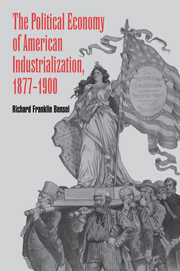Book contents
- Frontmatter
- Contents
- List of Tables
- List of Maps and Charts
- Preface
- Chapter 1 Introduction
- Chapter 2 Uneven Economic Development in the United States
- Chapter 3 Platform Demands, Party Competition, and Industrialization
- Chapter 4 Claims on Wealth and Electoral Coalitions
- Chapter 5 Political Construction of the National Market
- Chapter 6 Political Administration and Defense of the Gold Standard
- Chapter 7 Tariff Protection and the Republican Party
- Chapter 8 Conclusion
- Index
Chapter 4 - Claims on Wealth and Electoral Coalitions
Published online by Cambridge University Press: 27 March 2010
- Frontmatter
- Contents
- List of Tables
- List of Maps and Charts
- Preface
- Chapter 1 Introduction
- Chapter 2 Uneven Economic Development in the United States
- Chapter 3 Platform Demands, Party Competition, and Industrialization
- Chapter 4 Claims on Wealth and Electoral Coalitions
- Chapter 5 Political Construction of the National Market
- Chapter 6 Political Administration and Defense of the Gold Standard
- Chapter 7 Tariff Protection and the Republican Party
- Chapter 8 Conclusion
- Index
Summary
Much of political conflict in the late nineteenth century was shaped by contending visions of the national political economy. The most powerful of these was the laissez-faire model of competitive capitalism that both figuratively and in reality liberated corporate-led industrialization. Like all ideological models, this vision served several purposes: It provided an interpretation of industrial expansion that made the process intelligible to the mass public; it legitimated that process by illustrating the beneficial aspects of capitalism as an organizing form for social energy and production; and it stipulated the place and available opportunities of individuals within society. Like all ideological models, the proffered explanations highlighted the leading role of the promulgators: the industrial and commercial elite of the nation. As such, this vision of the national political economy was both deeply rooted in material reality and selectively focused on particular aspects of that reality. As an interpretation of social possibility, this vision more closely resembled the status quo than alternatives, a competitive advantage of no insignificance in that the most important alternative ideological models both were programmatically incompatible and represented but a minority, in each case, of the electorate.
As the preceding discussion of platform demands demonstrated, the Greenbackers and Populists, as well as each of the major parties, constructed alternative political programs for American economic development. Each program possessed a clear, material foundation within a major portion of the national political economy; a logic within which a plan of political action could be legitimated; and a vision within which major elements of the electorate could identify both themselves and their interests.
- Type
- Chapter
- Information
- The Political Economy of American Industrialization, 1877–1900 , pp. 205 - 288Publisher: Cambridge University PressPrint publication year: 2000



